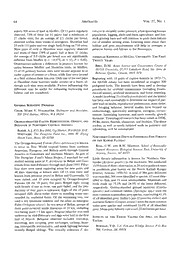
Orange-breasted falcon reproduction, density, and behavior in northern Central America PDF
Preview Orange-breasted falcon reproduction, density, and behavior in northern Central America
64 Abstracts VoL. 27, No. 1 mately 900 acres of land at Moffett. Of 15 pairs regularly roleucus is certainly under pressure; a fast-growing human observed, 73% of these (or 11 pairs) had a minimum of population, logging, slash-and-burn agriculture, and live- 27 chicks total, for an average of 2,5 chicks per brood, stock grazing have and will continue to push these falcons observed within three weeks of emergence. Shoreline had out of suitable nesting areas. Learning more about their 23 owls (11 pairs and one single bird) living on 750 acres. habitat and prey requirements will help in attempts to Nine pairs of owls at Shoreline were regularly observed preserve forests and falcons in the Neotropics. and seven of these (787o of pairs) had at least 21 chicks; the average of 3.0 chicks per brood was not significantly American Kestrels at McGill University: The First different from Moffett (t = —0.975; df = 15; 7* = 0.05). Twenty Years Observations indicate a difference in primary burrow lo- Bird, D.M. Avian Science and Conservation Centre of cation between Moffett and Shoreline birds. At Moffett, McGill University, 21,111 Lakeshore Road, Ste. Anne de 15 of 19 primary burrow sites were located adjacent to or Bellevue, Quebec, Canada, H9X 3V9 under a piece of cement or a fence, while four were located in a field without these features. Only one of the owl pairs Beginning with 10 pairs of captive kestrels in 1972-73, at Shoreline chose burrows under cement or a fence, al- the McGill colony has been established at roughly 300 though such sites were available. Factors influencing this pedigreed birds. The kestrels have been used to develop difference may be useful for enhancing burrowing owl procedures for artificial insemination (including frozen- habitat and are considered. thawed semen), artificial incubation, and forest renesting. A model involving Trichinellapseudospiralis and the kestrel has been used successfully to determine the impact of par- General Scientific Program asite load on health, reproductive performance, mate choice, and foraging behavior. Several studies have focused on Chair; Mark V. Stalmaster, Stalmaster and Associates, endocrinology, specifically androgens, estrogens, cortico- WA 209 23rd Avenue, Milton, 98354 sterone, luteinizing hormone, and more recently, growth hormone. Toxicological research has been aimed at DDE, Orange-breasted Falcon Reproduction, Density, and PCBs, mirex, fluoride, aluminum, and fenthion. The above Behavior in Northern Central America studies, as well as newly initiated work on paternity and WA inbreeding, will be summarized. Baker, A.J. P.O. Box 2492, GigHarbor, 98335. D.F. Whitacre. The Peregrine Fund Inc., 5666 W. Flying Hawk Lane, Boise, ID 83709 Northern Goshawk Diets in Ponderosa Pine Forests ON the Kaibab Plateau The Orange-breasted Falcon {Falco deiroleucus) is known to occur in New World tropical forests from northern BoaL, C.W. and R.W. Mannan. School ofRenewable Argentina, Paraguay, and Bolivia north through Central Natural Resources, Biological Sciences East, University of America to Guatemala and southeast Mexico. As part of Arizona, Tucson, AZ 85721 The Peregrine Fund’s Maya Project, I searched for and Little dietary information is known for Northern Gos- studied nesting pairs of F. deiroleucus in Belize and Gua- hawks (Accipitergentilis) in the southwest. We conducted temala frommid-February through mid-June 1992. Fifty- 1539 hours ofdirect observation at 20 active goshawk nests four days were spent exploring areas for new pairs and in ponderosa pine forests on the North Kaibab Ranger 48 days observing at known sites. Of 13 sites (new and District, Arizona, 1990-92. A total of 384 prey deliveries known from previous years) in Belize and Guatemala, 12 was recorded, 306 were identified to species, 63 were iden- were visited, and 10 were occupied by Orange-breasted tified to class, and 15 were unidentifiable. Mammals and Falcons. Of the 10 pairs, five pairs fledged eight young birds made up 75.1% and 24.9% of the items delivered, with broods of one to three, one pair failed, and the pro- respectively. Golden-mantled ground squirrels {Citellus ductivity of four pairs is unknown. Eight of the 10 pairs lateralis) and cottontail rabbits (Sylvilagus spp.) were the occupied cliffs above either rivers or standing water sur- most common mammalian prey species, constituting 41.1% rounded by unaltered forest. Of the remaining two, one of all identified prey. Steller’s jays {Cyanocitta stelleri) and used a dry limestone sinkhole and the other an emergent northern flickers (Colaptes auratus) were the most common Palm (Orbignya cohune). In two areas of Belize, groups of avian prey species and constituted 16.0% of all identified three pairs occurred inside diameters of 10 km, including prey. Mean prey delivery ratewas 0.25 deliveries perhour. two facing pairs <1 km apart. Nuptial behavior was well underway by mid-February and eggs were laid in the first Effects of the Exxon Valdez Oil Spill on Bald half of March. Behavior observed included courtship, Eagles mounting, nest scraping, prey exchanges, caching, hunt- ing, interspecific territoriality, and mock fighting between Bowman, T.D. U.S. Fish and Wildlife Service, P.O. Box AK recently fledged siblings. The virtually unknown F. dei~ 768, Cordova, 99574
